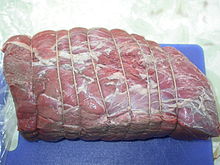Meat
Most meat roasts are large cuts of meat. Many roasts are tied with string prior to roasting, often using the reef knot or the packer's knot.[4] Tying holds them together during roasting, keeping any stuffing inside, and keeps the roast in a round profile, which promotes even cooking.[5] Prior to roasting in an oven, meat is generally "browned" by brief exposure to high temperature. This imparts a traditional flavor and color to the roast. Red meats such as beef, lamb, and venison, and certain game birds are often roasted to be "pink" or "rare", meaning that the center of the roast is still red. Roasting is a preferred method of cooking for most poultry, and certain cuts of beef, pork, or lamb. Although there is a growing fashion in some restaurants to serve "rose pork", temperature monitoring of the center of the roast is the only sure way to avoid foodborne disease.[6] In Britain, Ireland, and Australia a roast of meat may be referred to as a joint, or a leg, if it is a leg.

Browning is the process of partially cooking the surface of meat to help remove excessive fat and to give the meat a brown color crust and flavor through various browning reactions. Ground meat will frequently be browned prior to adding other ingredients and completing the cooking process. The process is commonly used when adding ground meat to casseroles or other prepackaged food products like Hamburger Helper, where the final cooking temperature will not be high enough to initiate the Maillard reaction. [edit]Techniques It is typically done using a skillet or frying pan, which generally should be preheated to a medium high temperature to avoid sticking. In order to brown properly, the meat should first have surface moisture removed. This is usually achieved by patting the meat with a paper towel. The function of this is to remove water which creates steam instead of evenly browning the meat.[1] When browning ground beef, the meat is stirred during cooking to break it up and to promote even browning. Onions and seasonings are sometimes added during the browning process. When the pink color has disappeared and the meat has reached the desired degree of brownness, the pan is removed from the heat and the excess fat is drained off. The Maillard reaction (/ma??j?r/my-yar; French pronunciation: ?[maja?]) is a form of nonenzymatic browning. It results from a chemical reaction between an amino acid and a reducing sugar, usually requiring heat. Vitally important in the preparation or presentation of many types of food, it is named after chemist Louis-Camille Maillard, who first described it in 1912 while attempting to reproduce biological protein synthesis.[1][2](p79) The reactive carbonyl group of the sugar reacts with the nucleophilic amino group of the amino acid, and forms a complex mixture of poorly characterized molecules responsible for a range of odors and flavors. This process is accelerated in an alkaline environment (e.g., lye applied to darken pretzels), as the amino groups are deprotonated and, hence, have an increased nucleophilicity. The type of the amino acid determines the resulting flavor. This reaction is the basis of the flavoring industry. At high temperatures, acrylamide can be formed. In the process, hundreds of different flavor compounds are created. These compounds, in turn, break down to form yet more new flavor compounds, and so on. Each type of food has a very distinctive set of flavor compounds that are formed during the Maillard reaction. It is these same compounds flavor scientists have used over the years to make reaction flavors.